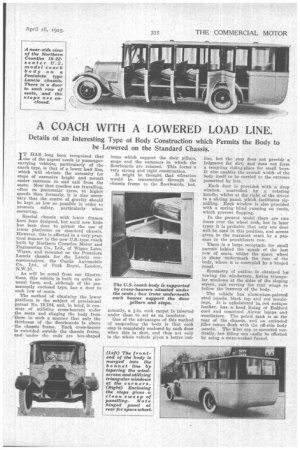A COACH WITH A LOWERED LOAD LINE.
Page 11

If you've noticed an error in this article please click here to report it so we can fix it.
Details of an Interesting Type of Body Construction which Permits the Body to be Lowered on the Standard Chassis.
TT HAS long been recognized that _Lone of the urgent needs in passengercarrying vehicles, particularly of the coach type, is that of a lower load line, which will obviate the necessity for steps of excessive height and permit easier entrance to and exit from the seats. Now that coaches are travelling, often On pneumatic tyres, at higher speeds than formerly, it is also necessary that the centre of gravity should be kept as low as .possible in order to promote safety, particularly when cornering.
Special chassis with lower frames have been designed, but until now little has been done to permit the use of lower platforms on standard chassis. However, this is affected in a Very practical manner in the new U.S.-type coach built by Northern Counties Motor and Engineering Co., Ltd., of Wigan Lane, Wigan, and mounted on the Pentaiota Lancia chassis for the Lancia concassionnaires, the Curtis Automobile Co., Ltd., of Park Royal, London, N.W.10.
As will be noted from our illustrations, this vehicle is built on quite unusual lines, and, although of the per-, manently enclosed type, has a door to each row of seats.
The method of obtaining the lower platform is the subject of provisional patent No. 19.184, and, in brief, it consists of utilizing cross-bearers under the seats and slinging the body from "these in such a manner that only the thickness of the floorboards is above the chassis frame. Each cross-bearer Is extended outside the chassis frame, and 'under the ends are box-shaped irons which support the door pillars, steps and the summers in which the floorboards are rebated. This forms a very strong and rigid construction.
It might be thought that vibration would be transmitted through the chassis frame to the floorboards, but, actually, a i-in. cork carpet is inserted under them to act as an insulator.
One of the advantages of this method of suspending the body is that each step is completely enclosed by each door when this is shut, and thus not only is the whole vehicle given a better out
line, but the step does not provide a lodgment for dirt, and does not form a tempting riding-place for small boys. It also enables the overall width of the body itself to be carried to the extreme permitted by law.
Each door is provided with a drop window, controlled by a rotating handle, whilst at the right of the driver is a sliding panel, which facilitates signalling. Each window is also provided With a spring blind running on cords, which prevent flapping.
In the present model -there are EWO doors over the wheel arch, but in later types it is probable that only one door will be uted in this position, and access given to the rearmost seats by a passage in the penultimate row.
There is a large• receptacle for small • parcels behind the squab of the last row of seats, whilst the ,spare wheel is slung underneath the roar of the body, where it is concealed by a hinged panel.
Symmetry of outline is obtained bw vee-ing the windscreen,. fitting triangular windows at the sides of the sloping screen, and curving the rear wings to follow the ins-weep of the body.
• The vehicle has aluminium-painted steel panels, black top and red mouldings. It is upholstered in iced antique loather, has. a' head lining of Bedford cord and combined Airvac lamps and ventilators. The petrol tank is at the .rear of the chassis, and an. extended filler comes flush with the off-side body panels. 'The 'filler cap is mounted vertically, but filling can easily be effected by using a.swan-necked funnel.
































